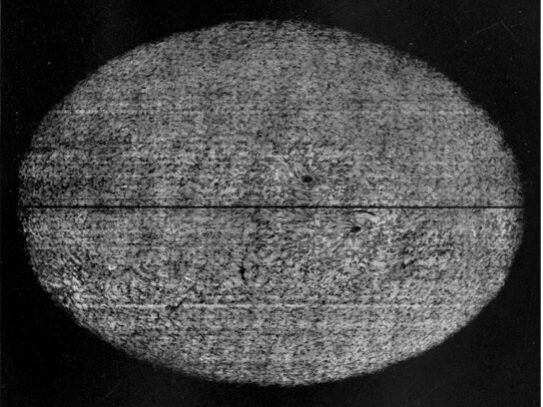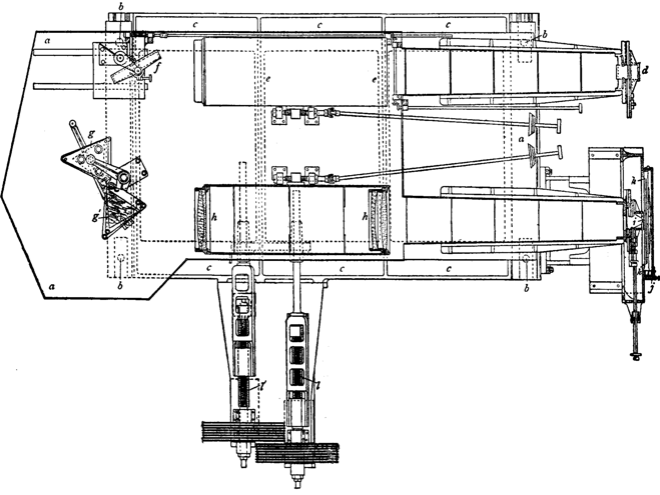Solar Flare captured by Skylab 4, using a spectroheliograph. Image Credits: NASA
About
The spectroheliograph is an instrument used in astronomy which captures a photographic image of the Sun at a single wavelength of light – a monochromatic image. The wavelength is usually chosen to coincide with a spectral wavelength of one of the chemical elements present in the Sun (a strong Fraunhofer line, usually the hydrogen-alpha or calcium K line).


Design and function
The spectroheliograph operates on the principle of selective filtration and imaging. It combines a telescope, a spectrograph, and a camera to capture monochromatic images of the Sun. It can also build a 3D model of the corona by taking measurements at wavelengths corresponding to increasingly high ionised states (and therefore higher distances from the Sun’s core).
The sunlight captured by a telescope is directed towards a narrow opening in a high-dispersion spectrograph. From there, the light passes through a collimating lens, which ensures that the light all becomes parallel. The collimated (or parallel) light then encounters a dispersive element, such as a prism or a diffraction grating, which disperses the light into its constituent wavelengths.
A secondary opening, positioned below the first one and within the focal plane of the spectrograph, selects a specific narrow range of wavelengths from the solar continuum. By moving the secondary opening across the Sun’s image and adjusting the secondary opening to maintain its spectral position, a 2D monochromatic photograph of the Sun is obtained on a photographic plate. Similarly, a spectrohelioscope achieves the same outcome, but produces an image we can see instead of obtaining a photograph we can study later. By replacing the photographic plate with an observer’s eye and simultaneously vibrating both openings with a small amplitude, a stable monochromatic image of a section of the solar disk becomes visible due to the persistence of vision (where the visual perception of an object does not cease for some time after the rays of light proceeding from it have ceased to enter the eye).
It is now possible to make a filter that transmits a narrow band of wavelengths which produces a similar image, but spectroheliographs remain in use.
Invention
Both George Ellery Hale (responsible for discovery of magnetic fields of sunspots), and Henri-Alexandre Deslandres (who studied the atmosphere of the Sun), invented the spectroheliograph independently in the 1890s. Robert R. McMath extended this functionality and made a ‘spectroheliokinematograph’ to include motion (kinematic) pictures of solar (helio) storms, which showed (spectrum) features on the Sun’s surface lasting from days to years.



The spectroheliograph enables scientists to study specific features of the Sun’s atmosphere in great detail. For example, by using different filters or dispersive elements, astronomers can focus on the hydrogen-alpha (Hα) wavelength, which reveals the Sun’s chromosphere and prominences.
Summary
- The spectroheliograph has played a vital role in advancing our knowledge of the Sun and its atmosphere.
- By capturing monochromatic images of the Sun in specific wavelengths, this instrument has allowed scientists to study the intricacies of the solar atmosphere – including prominences, flares, and other dynamic phenomena.
- With ongoing advancements in technology, spectroheliographs continue to be invaluable tools for solar astronomers, enabling us to unravel the mysteries of our nearest star.
Further reading
Spectroheliograph, David Darling, (2016), (Accessed: 2023-Jun-25)
Encyclopædia Britannica, 11th ed., 1911, v. 25, between p. 619, George Ellery Hale , Mechanical diagram of a spectroheliograph, a scientific instrument for making photographs of the sun at specific wavelengths, (Accessed: 2023-Jun-25)
Encyclopædia Britannica, 11th ed., 1911, v. 25, between pp. 618 and 619, George Ellery Hale, Spectroheliograph of the sun showing right and left handed sunspot vortices, Image retrieved from Original file. (Accessed: 2023-Jun-25)
Michard, R (2008). “Deslandres, Henri.” Complete Dictionary of Scientific Biography. Detroit: Charles Scribner’s Sons. pp. 68–70. Retrieved 13 June 2015.
The World’s Work: A History of Our Time, Volume XXV, Garden City: Doubleday, Page & Company, Portrait of George Ellery Hale, 1913, Image retrieved from Original file (Accessed: 2023-Jun-25)
Robert McMath, NOIRLab, National Optical-Infrared Astronomy Research Laboratory (NOIRLab)., (NOIRLab/NSF/AURA), Solar physicist Robert Raynolds McMath, Original file may be retrieved from: Original file(Accessed: 2023-Jun-30)
Bulletin de la société astronomique de France, 1913, Henri-Alexandre Deslandres (1853-1948), before 1913, Image retrieved from Anri_deslandres.jpg. (Accessed: 2023-Jun-25)